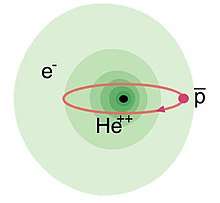Antiprotonic helium
Antiprotonic helium is a three-body atom composed of an antiproton and an electron orbiting around a helium nucleus. It is thus made partly of matter, and partly of antimatter. The atom is electrically neutral, since both electrons and antiprotons each have a charge of −1, whereas helium nuclei have a charge of +2.

Production
These exotic atoms can be produced by simply mixing antiprotons with ordinary helium gas; the antiproton spontaneously removes one of the two electrons contained in a normal helium atom in a chemical reaction, and then begins to orbit the helium nucleus in the electron's place. This will happen in the case of approximately 3% of the antiprotons introduced to the helium gas. The antiproton's orbit, which has a large principal quantum number and angular momentum quantum number of around 38, lies far away from the surface of the helium nucleus. The antiproton can thus orbit the nucleus for tens of microseconds, before finally falling to its surface and annihilating.
Laser spectroscopy
Antiprotonic helium atoms are under study by the ASACUSA experiment at CERN. In these experiments, the atoms are first produced by stopping a beam of antiprotons in helium gas. The atoms are then irradiated by powerful laser beams, which cause the antiprotons in them to resonate and jump from one atomic orbit to another.
Measurement of the mass ratio between the antiproton and electron
By measuring the particular frequency of the laser light needed to resonate the atom, the ASACUSA experiment determined the mass of the antiproton, which they measured at 1836.1536734(15) times more massive than an electron.[1] This is the same as the mass of a "regular" proton, within the level of certainty of the experiment. This is a confirmation of a fundamental symmetry of nature called CPT (short for charge, parity, and time reversal). This law says that all physical laws would remain unchanged under simultaneous reversal of the charge axis, parity of the space axes, and the orientation of the time axis. One important prediction of this theory is that particles and their antiparticles should have exactly the same mass.
Comparison of antiproton and proton masses and charges
By comparing the above results on laser spectroscopy of antiprotonic helium with separate high-precision measurements of the antiproton's cyclotron frequency carried out by the ATRAP and BASE collaborations at CERN, the mass and electric charge of the antiproton can be precisely compared with the proton values. The most recent such measurements show that the antiproton's mass (and the absolute value of the charge) is the same as the proton's to a precision of 0.5 parts in a billion.
Antiprotonic helium ions
An antiprotonic helium ion is a two-body object composed of a helium nucleus and orbiting antiproton. It has an electric charge of +1. Cold ions with lifetimes of up to 100 ns were produced by the ASACUSA experiment in 2005.
See also
References
- Hori, M.; et al. (2016). "Buffer-gas cooling of antiprotonic helium to 1.5 to 1.7 K, and antiproton-to-electron mass ratio". Science. 354 (6312): 610–4. Bibcode:2016Sci...354..610H. doi:10.1126/science.aaf6702. PMID 27811273.